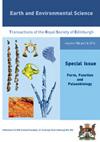螺旋体球粒陨石Karpinskiprion(nom.nov.)(Eugeneodontiformes)的牙齿轮生结构、生长和功能及其家族组成的修正
IF 1.2
4区 地球科学
Q4 GEOSCIENCES, MULTIDISCIPLINARY
Earth and Environmental Science Transactions of the Royal Society of Edinburgh
Pub Date : 2022-12-01
DOI:10.1017/S1755691022000251
引用次数: 0
摘要
摘要:对1902年来自北美的Campyloprion annectans Eastman的重新研究表明,这两个标本在物种水平上都不是诊断性的;因此,该种的名称是一个名称dubium。由于该物种被指定为该属的模式物种,这也需要抑制属名。另一个早期归属于Campyloprion的物种,Campyloprion-ivanovi-Karpinsky,1924被用作新建立的Karpinskiprion Lebedev et Itano gen.nov属的模式。回顾了Helicopionidae Karpinsky科的组成,1911,和一个新的Helicopiodontidae Itano et Lebedev fam。十一月成立。最近在俄罗斯伏尔加格勒地区发现的一个新的伊凡诺维卡平斯基虫标本(卡平斯基,1924年)是迄今为止发现的最完整的卡平斯基病毒标本。它明确地展示了这些齿轮匝的盘绕性质,并提供了关于其发育阶段的信息。在器官发生过程中,牙冠的切割刀片被重塑,基部刺逐渐拉长,形成一个磨碎器。通过在早期矿化基底上添加新冠,然后在后期进行刺状生长,从而实现了旋状生长。与一贯均匀的切割刀片相比,毛刺通常是畸形的,并带有生长中断的痕迹。齿轮圈的外圈两侧均具有寿命磨损面。最年轻的(舌侧)牙冠尚未受到磨损的影响。保存最完好的刻面显示平行的径向划痕。Karpinskiprion的上颚齿列尚不清楚,但我们认为刻面区域是与此处的拮抗性牙齿结构相互作用的结果。对于这种相互作用,提出了三种可能的假设:(a)两个相对的螺纹充当剪刀片,从一侧交替移动到另一侧;(b) 所述下齿轮圈配合在所述相对颌的成对副交感神经齿轮圈之间;或(c)安装到上颌中的牙齿铺面中的下牙螺纹。本文章由计算机程序翻译,如有差异,请以英文原文为准。
Tooth whorl structure, growth and function in a helicoprionid chondrichthyan Karpinskiprion (nom. nov.) (Eugeneodontiformes) with a revision of the family composition
ABSTRACT Restudy of Campyloprion annectans Eastman, 1902 from North America demonstrated that neither specimen included is diagnostic at the species level; thus, the species name is a nomen dubium. Since this species was designated as the type species of the genus, this requires suppression of the generic name also. Another species earlier assigned to Campyloprion, Campyloprion ivanovi Karpinsky, 1924 is used as a type for a newly established genus Karpinskiprion Lebedev et Itano gen. nov. The composition of the family Helicoprionidae Karpinsky, 1911 is reviewed, and a new family Helicampodontidae Itano et Lebedev fam. nov. is erected. A new specimen of Karpinskiprion ivanovi (Karpinsky, 1924) recently discovered in the Volgograd Region of Russia is the most complete Karpinskiprion specimen ever found. It unambiguously demonstrates the coiled nature of these tooth whorls and presents information on their developmental stages. During organogeny, cutting blades of the crown became reshaped, and basal spurs progressively elongated, forming a grater. Whorl growth occurred by addition of new crowns to the earlier mineralised base followed by later spur growth. In contrast to consistently uniform cutting blades, spurs are often malformed and bear traces of growth interruption. Both sides of the outer coil of the tooth whorl bear lifetime wear facets. The youngest (lingual) crowns are as yet unaffected by wear. The best-preserved facets show parallel radially directed scratch marks. The upper jaw dentition of Karpinskiprion is unknown, but we suggest that the faceted areas resulted from interaction with the antagonistic dental structures here. Three possible hypotheses for this interaction are suggested: (a) two opposing whorls acted as scissor blades, moving alternately from one side to another; (b) the lower tooth whorl fitted between paired parasymphyseal tooth whorls of the opposing jaw; or (c) the lower tooth whorl fitted into a dental pavement in the upper jaw.
求助全文
通过发布文献求助,成功后即可免费获取论文全文。
去求助
来源期刊
CiteScore
2.00
自引率
0.00%
发文量
21
期刊介绍:
Earth and Environmental Science Transactions (formerly Transactions of the Royal Society of Edinburgh: Earth Sciences) is a general earth sciences journal publishing a comprehensive selection of substantial peer-reviewed research papers, reviews and short communications of international standard across the broad spectrum of the Earth and its surface environments. The journal prides itself on the quality of its graphics and photographic reproduction. The Editors are keen to encourage interdisciplinary papers and Transactions also publishes occasional special symposia and invited volumes of specific interest.
We are currently in the process of digitising the archive of RSE Publications, and the archive of the Transactions, dating back to 1788, will be available from the back issues link on this site.

 求助内容:
求助内容: 应助结果提醒方式:
应助结果提醒方式:


